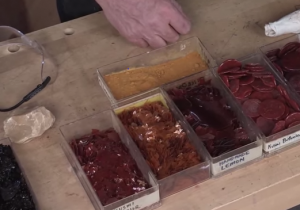We may receive a commission when you use our affiliate links. However, this does not impact our recommendations.
This 11-minute video excerpt, featuring the one and only Don Williams, is a fairly complete answer to a common question – what is shellac?
I say “fairly complete” because the video generated a couple follow-up questions in my mind. Fortunately, there’s WIA – our annual woodworking conference. Don spoke for 4 hours at the conference this weekend, covering shellac and a lot more. It was a real pleasure to sit in the audience and take it all in.
What Shellac is Not
Shellac is not lacquer. Both are high-performance, clear wood finishes originating in Asia, and both have names that derive from the same Sanskrit word (laksha), but lacquer is made from tree resin. Shellac, on the other hand, is made from bug excretions. Yes, the bug excretions are themselves made from tree resin, but that’s a big difference.
OK, Then What is Shellac?
 Shellac is a processed form of a bug exudate (various types of excretions), specifically the Indo-Chinese bug laccifer laca. Woodworkers in North America and Europe have imported it for use as a clear finish for a couple centuries.
Shellac is a processed form of a bug exudate (various types of excretions), specifically the Indo-Chinese bug laccifer laca. Woodworkers in North America and Europe have imported it for use as a clear finish for a couple centuries.
Processing begins with the raw form – called stick lac, because it comes right off the tree twigs. Early in history, the only desirable product from this work was a brightly colored dye. Later, workers began using a byproduct of the dye-making process, seed lac, to create and sell the wood finish material that we are talking about here.
Seed lac, button lac and shellac (named for its shell-like appearance) are forms, rather than quality grades. That’s important to remember.
Other terms you’ll encounter when shopping for this type of wood finish are: lemon, blonde, and various gem-related words, such as ruby. Don tells us that these terms all refer to whether or not the wax has been removed from the lac. For some applications, you’ll want the wax. At other times you will want to use de-waxed versions.
Is There a “Made in the USA” Equivalent?
North American bugs have always lost this economic competition. There simply is no American-made, natural shellac.
Historically, before imported shellac was available and affordable, we did develop a few clear finishes of our own – namely linseed oil, beeswax and colophony (pine rosin). At WIA, Don passed around 3 cabinet legs that showed each of these options, plus a fourth leg with a shellac finish. It was interesting to see the difference. Shellac was by far the nicest finish.
Now that you know what shellac is, it’s time to learn how to apply it. Buy the Don Williams DVD, “Creating Historic Furniture Finishes” and get started!
–Dan Farnbach
Here are some supplies and tools we find essential in our everyday work around the shop. We may receive a commission from sales referred by our links; however, we have carefully selected these products for their usefulness and quality.








One of the most interesting videos I’ve seen here. Great job and I’ll be looking for more from Don Williams.
Hey Dan,
Shellac is a secretion not an excretion.
Just like honey is not bee poop.
Blessings.